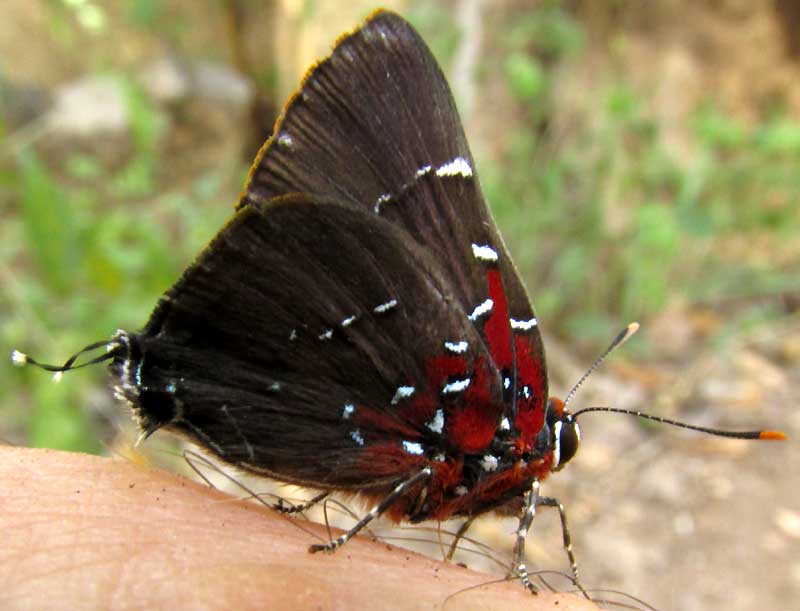Excerpts from Jim Conrad's
Naturalist Newsletter
from the February 15, 2019 Newsletter issued from Rancho Regensis north of Valladolid, Yucatán, MÉXICO;
elevation ~40m (~130 ft), N~20.876°, W~88.170°
WIDESPREAD BRANGAS HAIRSTREAK

As I stepped from the garden an usually tiny, blackish butterfly on the ground spread his wings for about a second, displaying a flash of bright, powder-blue. When the wings returned to their normal position folded together atop the butterfly's abdomen, all I could see was a black butterfly. It wasn't until I scooped the little being into my hand -- it seemed stunned or somehow unable to fly -- and took a closer look, that some colorful details showed up, as shown in the picture atop this page.
Those hairlike items at the butterfly's rear end, at the image's left side, tell us that this is a species of that group of small butterflies known as hairstreaks, members of the Gossamer-Wing Butterfly Family, the Lycaenidae, the Hairstreak Subfamily, the Theclinae . The hairs serve to make the rear end look like the butterfly's head, the hairs suggesting antennae. If you look closely at markings near the hairs' bases, they're arranged like markings on the head. Predators may attack the rear end, then, for if the head is destroyed the rest of the body will be easier to handle.
I knew that volunteer identifier Bea in snow-clogged, frozen-up Ontario would be happy to try her hand on this one, and she was. Within minutes of receiving the photograph she wrote back giving the names of two species that look like ours, both said to occur in southern Mexico. However, only one of the species is listed on a Mexican governmet web page listing butterfly species found in the Yucatán, compiled by Rodriguez, Villalobos and del Carmen Pozo de la Tijera, and that's BRANGAS NEORA, the Widespread Brangas, widely distributed from Mexico to southern Brazil.
Pictures of the Widespread Brangas found on the Internet show individuals with markings just like ours, but with the wing undersurface background color much lighter than our nearly black one.
Very little information is available on this species, just a few pictures and some locations where it's been collected. Maybe someday someone will be pleased to learn that in early February in the northern Yucatan an exceptionally black-winged form of the little Brangas neora can be seen.